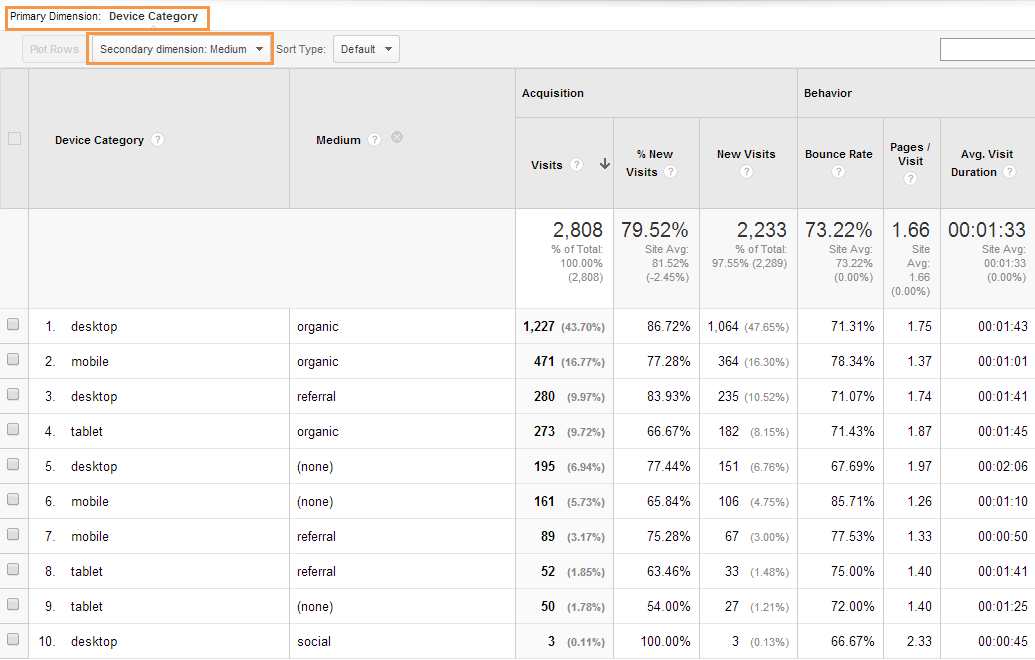Optimizing SEO with Secondary Dimension in Google Analytics
Optimizing SEO with Secondary Dimension in Google Analytics
Blog Article
Unlock Deeper Insights With Additional Measurement in Google Analytics
With the substantial stretch of information available in Google Analytics, the usage of secondary dimensions can considerably enrich your logical abilities. By strategically integrating additional dimensions right into your analysis, you can uncover beneficial understandings that could otherwise continue to be obscure - Secondary Dimension in Google Analytics.
Comprehending Key Vs. Second Dimensions
When analyzing information in Google Analytics, it is important to identify in between secondary and main dimensions to gain much deeper insights into individual actions. Primary measurements are the major groups by which you can watch your information, such as landing, source/medium, or gadget page. These measurements supply the fundamental framework for organizing and recognizing your data. On the various other hand, second dimensions permit you to further study your primary dimension information. By adding a secondary dimension, you can layer on added information to your key measurement, allowing a much more granular evaluation. If your primary measurement is the source/medium through which users got here on your website, adding a secondary measurement like geographical location can expose where those customers are situated geographically. When looking at the main dimension alone, this added layer of information can help you determine fads, patterns, or abnormalities that might not have been obvious. For that reason, leveraging both main and second dimensions in Google Analytics is vital for extensive information evaluation and educated decision-making.
Making Use Of Additional Dimensions Successfully
By incorporating secondary measurements along with key dimensions, experts and marketing professionals can dig much deeper into the specifics of user communications on their sites. Second measurements enable users to segment and filter key measurement information better, using an extra comprehensive sight of customer demographics, habits, and interactions.
Moreover, second measurements enable individuals to compare and contrast various data factors within a single report, helping with a much more extensive analysis of user habits patterns. By leveraging second measurements efficiently, businesses can uncover surprise insights, optimize their advertising methods, and enhance the total customer experience on their sites.
Discovering Usual Secondary Measurement Mixes
To even more assess individual behavior and fads in Google Analytics, it is useful to discover typical mixes of additional dimensions. By incorporating different secondary dimensions, analysts and online marketers can obtain much deeper understandings into just how different aspects influence and engage website efficiency. Some common additional dimension mixes that give useful insights include evaluating website traffic resources with user locations to recognize where internet site site visitors are coming from geographically and exactly how they found the site. Similarly, combining touchdown pages with devices can disclose which pages carry out best on various tools, aiding in optimizing the internet site for far better customer experience. Furthermore, examining user behavior metrics with secondary dimensions such as demographics or passions can help in targeting specific audience segments a lot more successfully. By discovering these usual additional dimension mixes, businesses can reveal concealed patterns, identify opportunities for enhancement, and make data-driven decisions to enhance their on the internet presence.
Using Secondary Dimension in Custom-made Information
Using additional dimensions in personalized reports allows for a much more detailed analysis of data in Google Analytics, improving the deepness of insights gotten. When producing custom records in Google Analytics, including additional dimensions can provide an extra in-depth view of just how different measurements engage with each various other. This navigate to these guys function makes it possible for individuals to delve deeper into their data and discover valuable connections that might not be promptly obvious.
By using secondary measurements in customized records, users can get a much better understanding of their internet site or app web traffic. For example, integrating the key dimension of "source/medium" with the second this website measurement of "landing web page" can expose which touchdown pages are doing ideal for web traffic originating from details sources. This insight can assist marketing experts optimize their campaigns and enhance general conversion prices.

Enhancing Information Visualization With Additional Measurement
When checking out information in Google Analytics personalized reports, incorporating second dimensions not just offers a much more thorough analysis however also improves the visual depiction of understandings through data visualization. By including an additional measurement to your reports, you can improve the means data exists, making it easier to identify patterns, patterns, and correlations within your internet site's efficiency metrics.
Second measurements can help you segment your information further, enabling a much deeper understanding of why not check here user habits and communications on your site. This enhanced degree of granularity can be especially useful when attempting to separate particular variables that may affect your website's performance - Secondary Dimension in Google Analytics.

Final Thought
Finally, leveraging additional measurements in Google Analytics allows for an extra thorough evaluation of data, bring about deeper understandings and more enlightened decision-making. Secondary Dimension in Google Analytics. By including extra layers of info to primary information collections, marketing experts and experts can discover surprise trends, patterns, and correlations that supply a granular sight of user habits and interactions. This improved level of insight makes it possible for optimization of projects and customized methods for specific target market sectors, inevitably boosting efficiency and conversion prices
On the various other hand, additional dimensions permit you to further explore your key dimension information. By adding a secondary dimension, you can layer on added info to your main dimension, enabling an extra granular analysis. If your primary dimension is the source/medium through which individuals got here on your site, including an additional dimension like geographical location can reveal where those individuals are situated geographically. By incorporating secondary dimensions together with main dimensions, marketing experts and analysts can dig much deeper right into the specifics of customer communications on their sites. Secondary dimensions enable users to section and filter key measurement data even more, supplying an extra detailed sight of user habits, demographics, and communications.
Report this page